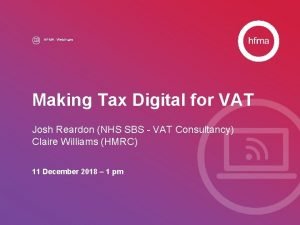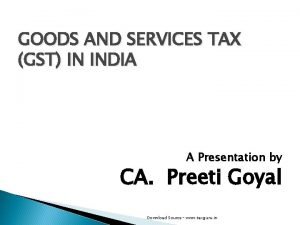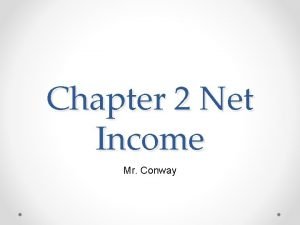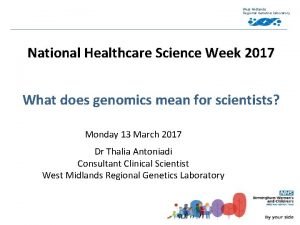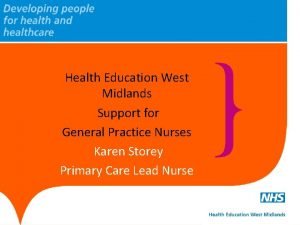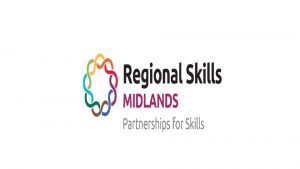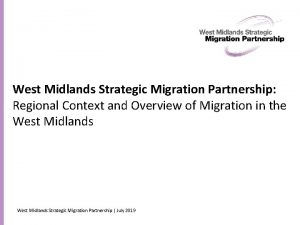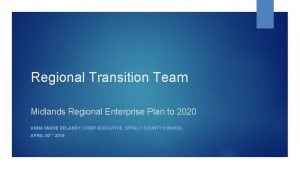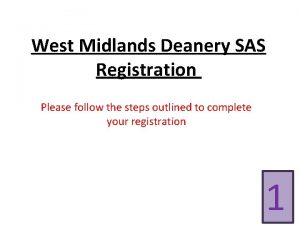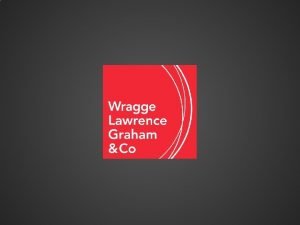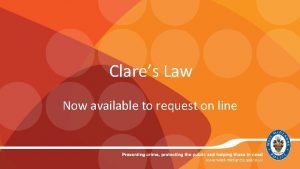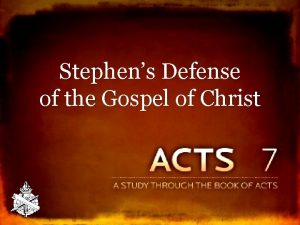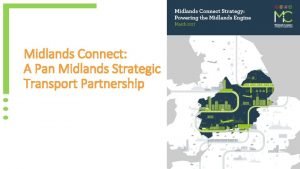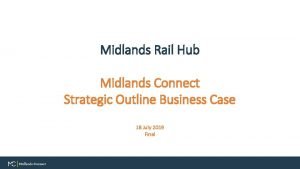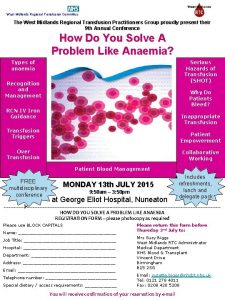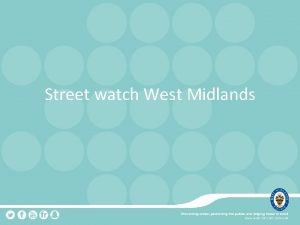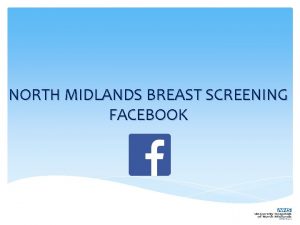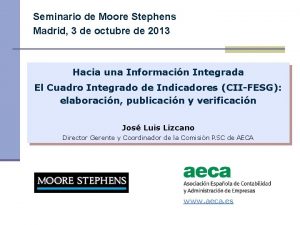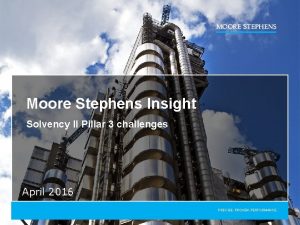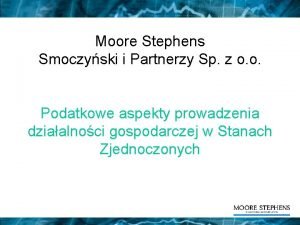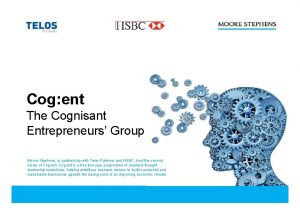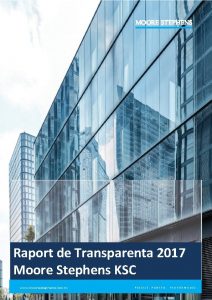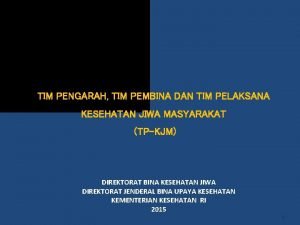MAKING TAX DIGITAL Moore Stephens East Midlands Tim

















- Slides: 17

MAKING TAX DIGITAL Moore Stephens East Midlands Tim Woodgates BSc (Hons) CTA ACCA MAAT

AGENDA - What is the point of Making Tax Digital? What is Making Tax Digital? Does Making Tax Digital Legislation affect my business? What does my business need to do? When does Making Tax Digital begin – is it delayed? How can my business prepare? Can I still use spreadsheets for my business records?

WHAT IS THE POINT OF MAKING TAX DIGITAL? Ø Reducing tax payer errors to improve the tax take Controversial premise Ø HMRC ambition to “become one of the most digitally advanced tax administrations in the world” Ø Recognition of new technological age

WHAT IS MAKING TAX DIGITAL? Ø All about how businesses and individuals interact with HMRC Ø Focus on digital records and digital submissions of data to HMRC Ø Making Tax Digital (MTD) only to apply for VAT purposes currently Ø No other taxes to brought into MTD until 2020 at the very earliest

DOES MTD AFFECT MY BUSINESS? YES, if you are: Ø VAT registered AND Ø Have taxable turnover above £ 85 k (VAT registration threshold) – i. e. exclude exempt turnover Ø Doesn’t matter whether you are a sole-trader, landlord, company, LLP, trust, charity, etc. Ø Once you're in – you’re in Only escape is to de-register from VAT Ø Not subject to MTD if your business is voluntarily registered for VAT

EXEMPTIONS Ø It’s not reasonably practicable because of age, disability, remoteness of location or for any other reason Ø Subject to an insolvency procedure Ø The business is run entirely by practising members of a religious society or order whose beliefs are incompatible with using electronic communications or keeping electronic records MUST APPLY TO HMRC

WHAT DOES MY BUSINESS NEED TO DO? Ø Your business must record its transactions in a digital format within “functional compatible software” and submit its VAT return directly to HMRC from that software. Ø Manual record-keeping therefore will not be a compliant system Ø Any manual re-keying of information for the VAT return is not MTD compatible – the VAT return should be submitted seamlessly to HMRC.

WHAT INFORMATION NEEDS TO BE RECORDED DIGITALLY? Ø Designatory data § Name of business § Address for principle place of business § VAT registration number Ø § § § Sales invoice Time of supply i. e. date Invoice value excluding VAT rate applying to the sale Ø § § § Purchase invoice Time of supply i. e. date Total invoice value excluding VAT Input VAT being claimed Ø VAT account • The creation of the VAT return essentially from the underlying records

WHAT INFORMATION NEEDS TO BE RECORDED DIGITALLY? Ø VAT adjustments can be journalled in i. e. fuel scale charge adjustments, partial exemption calculations, etc Ø No requirement to record digitally transactions that are outside of the VAT return i. e. wages paid Ø No need to create sales invoices digitally Ø Retailers – do not need to record every single transactions into their software. They must however record their daily gross takings in a digital format Ø The submission of the MTD VAT return is still only 9 totals

WHEN DOES MTD BEGIN? Ø VAT periods commencing on or after 1 April 2019 Ø First VAT return therefore 30 June 2019 Ø Deferred start date for complex VAT affairs of 1 October 2019: § § § VAT groups Annual Accounting Scheme businesses Trusts NFPs and local authorities Must have a letter from HMRC that Plus others states you are subject to the deferred start date.

HOW CAN MY BUSINESS PREPARE? Ø Review existing record keeping system § § is it already compliant? If already using software, are you on the latest version? Ø If not, you will need to look at either: A. Purchasing some form of “functional compatible software” B. Possibly outsourcing the VAT compliance to a third party

SOFTWARE Ø Issues to consider: § Cost - £ 6 p/m - £ 20 p/m or more? !! § Ease of use § Experience within business? § Recruitment? § Training? § Hardware cost? § Functions required? § Cloud based or standalone? Benefits: Ø Ability to involve other apps such as automatic bank feeds and expense scanning for example – cut processing time Ø Real time management information Ø Accountant access – less compliance based and more strategic advice and planning Ø More future-proof than spreadsheets

OUTSOURCING Ø Issues to consider: § Cost § Redeployment of bookkeeping staff § Timing of information to be provided Benefits: Ø Remove the MTD burden Ø Accessible on demand Ø Expert advice Ø Reduced employment costs Ø Efficiency gains Ø Benefits to tax planning and management reporting

CAN I USE SPREADSHEETS? YES Ø BUT you do need some form of “bridging software” to make it MTD compliant however Ø Bridging software operates as link between the business’s spreadsheet record and HMRC’s system (see next slide) Ø Likely to be the cheapest way of achieving MTD compliance Ø Need to consider how long this will be permissible however Ø Less powerful than a cloud based software option

BRIDGING SOFTWARE Ø Cost tends to be around £ 40+VAT per year Ø Operates by taking each part of the VAT return form and then directing the business to link it to the relevant cell within the spreadsheet Example: VAT registration number = link to cell A 4 Box 1 (Output VAT payable) = link to cell E 187 Box 4 (Input VAT claimed) = link to cell L 133 and so on Ø The business would then enter their HMRC account details (User ID and password) into the bridging software and then be able to submit the VAT return. Have a look at Absolute Excel VAT Filer https: //www. absoluteexcelvatfiler. co. uk/

PENALTIES Ø There will be a “soft landing approach” for the first 12 months Ø No penalties will be charged in the first 12 months if businesses aren’t maintaining records digitally Ø Points based system to apply from April 2020

THANK YOU Any questions? Tim Woodgates – Associate at Moore Stephens East Midlands Offices in Corby, Peterborough and Northampton tim. woodgates@moorestephens. com https: //www. linkedin. com/in/timwoodgates/ 01536 461900
 Rsc east midlands and humber
Rsc east midlands and humber South east midlands lep
South east midlands lep Professor ashley dennison
Professor ashley dennison Making tax digital webinars
Making tax digital webinars Gst conclusion
Gst conclusion Roland purcell a technical writer
Roland purcell a technical writer East south east wind direction
East south east wind direction Kalahari desert on africa map
Kalahari desert on africa map East is east and west is west
East is east and west is west West midlands regional genetics laboratory
West midlands regional genetics laboratory Walsall rugby
Walsall rugby Health education england west midlands
Health education england west midlands Regional skills fora
Regional skills fora West midlands strategic migration partnership
West midlands strategic migration partnership Midlands regional transition team
Midlands regional transition team West midlands deanery
West midlands deanery Iosh midlands
Iosh midlands Clares law west midlands police
Clares law west midlands police



